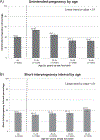Unintended pregnancy and interpregnancy interval by maternal age, National Survey of Family Growth
- PMID: 29501647
- PMCID: PMC6379777
- DOI: 10.1016/j.contraception.2018.02.013
Unintended pregnancy and interpregnancy interval by maternal age, National Survey of Family Growth
Abstract
Background: The relationship between unintended pregnancy and interpregnancy interval (IPI) across maternal age is not clear.
Methods: Using data from the National Survey of Family Growth, we estimated the percentages of pregnancies that were unintended among IPI groups (<6, 6-11, 12-17, 18-23, 24+ months) by maternal age at last live birth (15-19, 20-24, 25-29, 30-44 years).
Results: Approximately 40% of pregnancies were unintended and 36% followed an IPI<18 months. Within each maternal age group, the percentage of pregnancies that were unintended decreased as IPI increased.
Conclusion: Unintended pregnancies are associated with shorter IPI across the reproductive age spectrum.
Keywords: Birth spacing; Interpregnancy intervals; Postpartum contraception; Pregnancy intention.
Published by Elsevier Inc.
Figures


Similar articles
-
The Impact of Computing Interpregnancy Intervals Without Accounting for Intervening Pregnancy Events.Paediatr Perinat Epidemiol. 2018 Mar;32(2):141-148. doi: 10.1111/ppe.12458. Epub 2018 Mar 9. Paediatr Perinat Epidemiol. 2018. PMID: 29520836
-
Short interpregnancy intervals in the United States.Obstet Gynecol. 2013 Jul;122(1):64-71. doi: 10.1097/AOG.0b013e3182955e58. Obstet Gynecol. 2013. PMID: 23743455 Free PMC article.
-
Factors associated with pregnancy intention among women who have experienced a short birth interval: findings from the 2009 to 2011 Mississippi and 2009 Tennessee Pregnancy Risk Assessment Monitoring System.Ann Epidemiol. 2018 Jun;28(6):372-376. doi: 10.1016/j.annepidem.2018.03.012. Epub 2018 Mar 29. Ann Epidemiol. 2018. PMID: 29653799
-
Interpregnancy interval and risk of perinatal death: a systematic review and meta-analysis.BJOG. 2020 Nov;127(12):1470-1479. doi: 10.1111/1471-0528.16303. Epub 2020 Jun 16. BJOG. 2020. PMID: 32378279
-
Short interpregnancy intervals and adverse maternal outcomes in high-resource settings: An updated systematic review.Paediatr Perinat Epidemiol. 2019 Jan;33(1):O48-O59. doi: 10.1111/ppe.12518. Epub 2018 Oct 12. Paediatr Perinat Epidemiol. 2019. PMID: 30311955 Free PMC article.
Cited by
-
Meeting the Needs of Postpartum Women: Provider Perspectives on Maternal Contraceptive Care in Pediatric Settings.Acad Pediatr. 2023 May-Jun;23(4):821-828. doi: 10.1016/j.acap.2022.08.013. Epub 2022 Sep 5. Acad Pediatr. 2023. PMID: 36067921 Free PMC article.
-
Short interpregnancy interval and poor fetal growth: Evaluating the role of pregnancy intention.Paediatr Perinat Epidemiol. 2019 Jan;33(1):O73-O85. doi: 10.1111/ppe.12506. Epub 2018 Oct 16. Paediatr Perinat Epidemiol. 2019. PMID: 30326141 Free PMC article.
-
Does reversible postpartum contraception reduce the risk of pregnancy condition recurrence? A longitudinal claims-based study from Maine.Ann Epidemiol. 2024 Aug;96:58-65. doi: 10.1016/j.annepidem.2024.06.001. Epub 2024 Jun 15. Ann Epidemiol. 2024. PMID: 38885800 Free PMC article.
-
Ketogenic Diets and Chronic Disease: Weighing the Benefits Against the Risks.Front Nutr. 2021 Jul 16;8:702802. doi: 10.3389/fnut.2021.702802. eCollection 2021. Front Nutr. 2021. PMID: 34336911 Free PMC article. Review.
-
Medicaid Payments For Immediate Postpartum Long-Acting Reversible Contraception: Evidence From South Carolina.Health Aff (Millwood). 2021 Feb;40(2):334-342. doi: 10.1377/hlthaff.2020.00254. Health Aff (Millwood). 2021. PMID: 33523747 Free PMC article.
References
-
- US Department of Health and Human Services. Healthy People 2020 Objectives: Family Planning. Washington, DC.
-
- Conde-Agudelo A, Rosas-Bermudez A, Kafury-Goeta AC. Birth spacing and risk of adverse perinatal outcomes: a meta-analysisJAMA 2006;295:1809–23. - PubMed
-
- Conde-Agudelo A, Rosas-Bermudez A, Kafury-Goeta AC. Effects of birth spacing on maternal health: a systematic review. Am J Obstet Gynecol 2007;196: 297–308. - PubMed
-
- Gipson JD, Koenig MA, Hindin MJ. The effects of unintended pregnancy on infant, child, and parental health: a review of the literature. Stud Fam Plann 2008;39:18–38. - PubMed
MeSH terms
Grants and funding
LinkOut - more resources
Full Text Sources
Other Literature Sources

